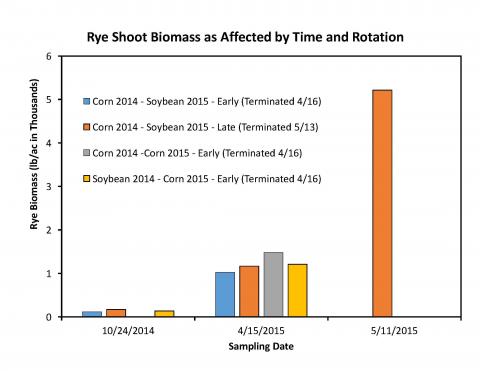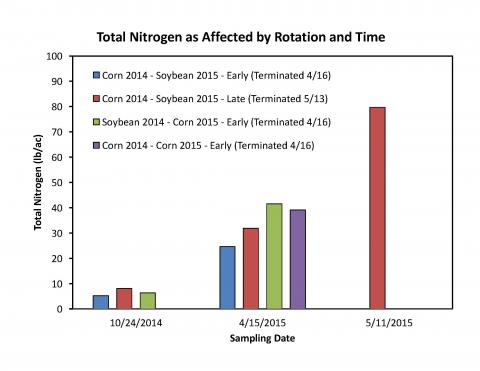By Daren Mueller, Extension Plant Pathologist
This study, funded by the United Soybean Board (USB), was conducted to understand the potential for cover crops to perform in a corn and soybean rotation, and to collect data on the performance of cover crops in those rotations in relation to the timing of termination.
The research showed winter cereal rye that grew an extra three weeks prior to soybeans produced about 300-400% more biomass (Fig. 1) with a 100% increase in nitrogen retention (Fig. 2), when compared with early terminated cover crops.
Results from this study showed no difference in soybean yield following a cover crop killed 3 weeks prior to soybean planting compared to a cover crop that was killed one day before soybean planting.
Experiments
The study consisted of three major experiments that included corn and soybean systems with and without the cover crop, winter cereal rye. The cover crop prior to corn was terminated about seven to 10 days before corn planting, while the cover crop prior to soybeans was terminated at two different times.

In one termination timing treatment, the cover crop prior to soybeans was terminated the same day that the cover crop was terminated in corn; simulating the farmer decision to terminate all cover crops at once.
In the second termination timing treatment, the cover crop was terminated the day before soybean planting, resulting in about 21 days of extra growth.
The more cover crop biomass production, the greater the benefits to farmers and the environment. Identification of management decisions that maximize cover crop biomass without affecting yield can make cover crops an economical choice that benefits crop production.
Cover crop biomass production is positively associated with nutrient retention and soil health (Fig. 2).
Cover crops before soybeans vs. cover crops before corn
Research showed that cover crops before soybeans provided more benefit than cover crops before corn because they have more time to grow. Cover crops produce more biomass before soybeans for two reasons:
1) Soybeans are planted on average three weeks after corn.
2) Cover crops can be terminated as little as one day before soybean planting without impacting soybean yield whereas, cover crops must killed at least 10 days before corn planting to avoid corn yield loss.

Conclusion
Short-term economic benefit: Despite letting the cover crop grow an extra three weeks, the data showed no negative effect on soybean yields. By increasing biomass production and retaining nitrogen, the system will build soil health and have a positive impact on water quality challenges.
Long-term economic benefit: In this study, leaving cover crops in the ground three weeks longer resulted in a 300-400% increase in biomass production.
This extra growth should improve soil health by leading to lower compaction, greater aeration, more organic matter, increased water-holding capacity, and nutrient retention.






Post a comment
Report Abusive Comment